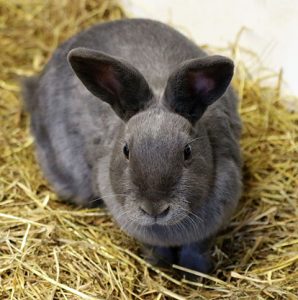In the past, the risks of surgery have put a lot of people off neutering their rabbits – however, this has led to an awful lot of unnecessary deaths of older bunnies with severe health problems. As a result, owners are often in a quandary, trying to decide which is best – to neuter or not to neuter? In this blog, we’ll explore some of the risks and benefits, and look at some of the factors that will help you come to the right decision for your rabbit.
How are rabbits neutered?
For bucks (males), neutering is called castration, and it’s a very simple procedure – under general anaesthetic (so he can’t feel anything), the scrotum (sac) is cut open, the testicles are removed, and the wound glued shut.
For does (females), it’s a bigger and more complicated procedure, called spaying, with an incision in the abdomen (belly) and the ovaries and uterus (womb) removed. Again, this occurs under general anaesthesia, and the wound is glued shut at the end.
So, what are the risks?
The biggest concern is the anaesthetic itself. In the past, many rabbits died as a consequence of anaesthesia; however, with modern drugs and skilled vets, the risk isn’t that much higher than in cats. Sometimes, you’ll hear people talking about the “1 in 70 mortality rate” from surgery in rabbits, but this is very misleading – this includes old and sick bunnies, as well as those who have to undergo emergency procedures, as well as routine operations like neutering. If we only look at healthy rabbits, the rate of severe complications drops to about 0.7%, and this is improving all the time as newer and safer drugs and procedures are introduced.
Other risks include hernias (in bucks), bleeding, and other surgical complications. Nowadays, however, these are very rare, as vets are much more experienced in performing rabbit operations than they were 20 or 30 years ago.
Sounds scarily high – why should I put my rabbit through it?
Because of the other risks that you’ll be avoiding by having them neutered!
Firstly, there’s the disease risk. Studies show that up to 80% of entire does will develop cancer of the uterus by the age of 5; whereas a neutered doe cannot develop this disease. In addition, she is much less likely to develop mammary tumours or reproductive infections (like a pyometra). This is less of an issue in bucks, but (like dogs and humans), they can develop testicular tumours and prostate disease if not castrated.
Secondly, there are pronounced behavioural improvements in many neutered bunnies. Entire bucks and does will mark their territory by spraying and leaving faecal pellets around, which although not harmful, is decidedly unpleasant for the rest of us. In addition, rabbits of both sexes usually become less aggressive after neutering and are more relaxed about the company they keep (which means they can live with friends ). As social animals, it is quite cruel to keep rabbits on their own; however, it is risky to keep entire bunnies with anyone else – all too often they’re constantly trying to either mate with or kill one another. As a result, a lot of entire rabbits spend their lives essentially in solitary confinement.
This leads on to the third benefit – no more litters! Left to their own devices, a pair of entire rabbits can have a litter (averaging about 6) every month from sexual maturity (at roughly 6 months, but as little as 4 months for miniatures such as the Netherland Dwarf). Over 7 years this means that, in theory, a single entire pair and their descendants could produce over 180 billion rabbits in a mere 7 years… Would you want to try and find homes for them all?!
There’s no right answer for every owner or every rabbit; so give us a ring if you want to talk about options.
